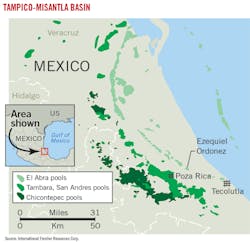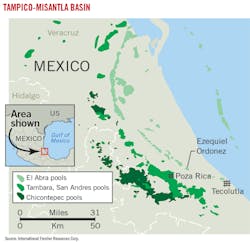Mexico’s Tampico-Misantla basin potential might rival US Permian basin
Mexico’s Tampico-Misantla super basin, which includes Chicontepec, is well known geologically but its remaining oil and natural gas potential has yet to be properly evaluated, a former executive vice-president of Petroleos Mexicanos (Pemex) told an American Association of Petroleum Geologists (AAPG) meeting.
Alfredo Guzman estimates Tampico-Misantla contains more than 150 billion bbl of original oil in place in conventional oil carbonate reservoirs, tight oil siliciclastics, and shales. The basin in coastal east-central Mexico has more than 70 fields already on stream although it is a low priority for Pemex.
During a Global Super Basins 2019 conference in Sugar Land, Tex., Guzman compared Tampico-Misantla shale’s characteristics with the Permian basin in West Texas and New Mexico.
The Permian’s Midland and Delaware subbasins started producing oil during the 1900s from conventional reservoirs featuring carbonate rocks. Today, most Permian oil production comes from horizontal multifractured wells tapping into source rocks.
Guzman said the Midland and Chicontepec subbasins are intracratonic depressions bordered by carbonate shelfs. Turbidite currents carried fine- to medium-grained sediments into the area.
Both Midland and Chicontepec have similar permeabilities, porosities, and multiple layers of mature, rich organic sediments that provide source rocks and very tight reservoirs.
Guzman calls Tampico-Misantla “a super-charged basin” containing late Jurassic source rocks. The 25,000-sq-km area can produce from at least 10 geologic levels, said Guzman, who hass studied the basin since the late 1980s. Mexico appointed Guzman to its National Hydrocarbons Commission created in 2008.
Mexico depended primarily upon Tampico-Misantla’s production in the early 1900s until Pemex discovered the Mesozoic Chiapas-Tabasco and Campeche Sound provinces.
Guzman said Pemex stopped exploring Tampico-Misantla and elsewhere in Mexico to reallocate its investments, drilling rigs, and expertise during the 1980s to Chiapas-Tabasco and Campeche Sound.
“Limited resources needed to be deployed in more profitable reservoirs, especially when all the production of the basin came to be only 3% of the national oil output,” Guzman said. “But for the country, it meant abandonment of one of the richest provinces of the world.”
Consequently, Tampico-Misantla received little attention for decades. Mexico’s President Enrique Pena Nieto’s administration adopted energy reforms in 2013, enabling upstream investment in Mexico by non-Mexican companies for the first time in 75 years.
The National Hydrocarbon Commission estimates 107 billion boe has been found in Tampico-Misantla with another estimated 144.3 billion boe in resources yet to be found.
“Only 7.8 billion boe have been extracted and only [another] 7 billion boe are considered reserves, which implies leaving in the ground almost 93 billion boe of the original discovery,” Guzman said. Chicontepec holds most of the 7 billon boe of reserves.
Ongoing exploration
Pemex and a few other Mexican operators are working in Tampico-Misantla. Renaissance Oil Corp. of Canada is among the non-Mexican operators studying the basin. Service companies Halliburton Corp. and Baker Hughes have been contracted to work the Chicontepec tight oil reservoirs.
The figure shows the area where Tonalli Energia spudded the first conventional horizontal well in its onshore Tecolutla block in Tampico-Misantla basin during 2018. Well TEC-11 penetrated the Cretaceous El Abra reef at about 2,310 m with a lateral of 1,000 m.
International Frontier Resources Corp., Calgary, a partner with Grupo Idesa in the Tonalli joint venture, said TEC-11 was the first well in a multiwell plan to develop a northern extension, which was identified with 3D seismic interpretation of Tecolutla oil field in Veracruz.
Separately, Keven Smith, Renaissance vice-president of business development, said Tampico-Misantla remains “a huge basin, a world-class basin, in terms of the oil it has produced to date and its potential…. We regard it as multi-zone, with different producing horizons, many of which are underexplored.”
Tampico-Misantla contains thick Upper Jurassic shale that has yet to be developed. Smith said this shale would have been developed already if it was a US or Canadian play.
Russia’s OAO Lukoil and Renaissance are partners in an integrated oil service (OFS) contract for the 60,000-acre Amatitlan block in the Chicontepec paleochannel formation within Tampico-Misantla basin.
Under the energy reforms, integrated OFS contracts are eligible to be migrated to exploration and production-sharing licenses.
OFS contracts were common in Chicontepec during the early 2000s when former Mexico President Vicente Fox announced a $75 billion, 20-year plan to develop the formation’s proved, probable, and possible reserves.
Fox forecast Chicontepec eventually could produce 1 million b/d but it has produced only about 32,000 b/d.
Renaissance and Lukoil are developing Amatitlan block as part of a group of integrated OFS contracts overseen by Halliburton Co., Vitol Inc., and Baker Hughes Inc., a GE company, as well as Mexico’s Constructora y Perforadora Latina.
In addition, Renaissance acquired 50% of Perforadora’s half-stake in the neighboring block near Poza Rica in Veracruz. The Pitepec integrated exploration and production contract is to explore and produce oil and gas. The 61,300-acre Pitepec block is adjacent to the Amatitlan block.
Smith said Chicontepec is very heterogeneous, requiring different exploration and development methods for each area. He is interested in Upper Jurassic shale packages about 3,000 m deep where core samples have been taken.
The Upper Jurassic shales of the Tampico-Misantla basin are believed to hold potential but have yet to be commercially developed.
Smith believes Amatitlan block will provide production from Upper Jurassic shales. He anticipates a multi-year horizontal drilling program.
Technology transfer
Guzman believes technology for unconventional plays can be applied from the Midland and Delaware subbasins to Tampico-Misantla basin.
“Tampico-Misantla could produce 2-3 million boe in less than 10 years, which would take Mexico back to its position as one of the world’s main producing countries, as in the case of the US thanks to the Permian,” Guzman said.
He believes Tampico-Misantla can reach record production provided it receives investment and technologies such as has been done in the Permian, which now produces oil from very low porosities and permeabilities.
“Downgraded volumes in Chicontepec will be reconsidered under the light of the application of new technologies and development plans and investment,” Guzman said. “The original oil and gas allocated to the Chicontepec subbasin is less than half of what many experts always [believed it would be]”
Guzman said Tampico-Misantla development is necessary because new offshore production will not come on stream until after 2022.
About the Author
Paula Dittrick
Senior Staff Writer
Paula Dittrick has covered oil and gas from Houston for more than 20 years. Starting in May 2007, she developed a health, safety, and environment beat for Oil & Gas Journal. Dittrick is familiar with the industry’s financial aspects. She also monitors issues associated with carbon sequestration and renewable energy.
Dittrick joined OGJ in February 2001. Previously, she worked for Dow Jones and United Press International. She began writing about oil and gas as UPI’s West Texas bureau chief during the 1980s. She earned a Bachelor’s of Science degree in journalism from the University of Nebraska in 1974.


